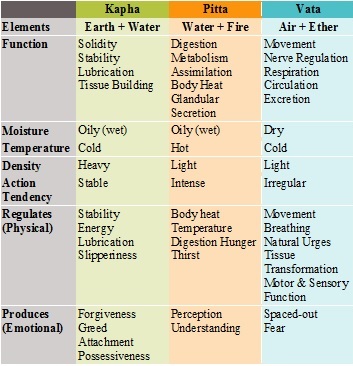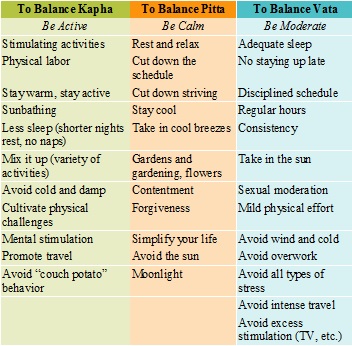Discovering Your Dosha & Finding Ayurvedic Balance
By Karta Purkh Singh Khalsa, Soothing Touch
This article, provided by Soothing Touch massage therapy products, offers a basic introduction to Ayurvedic doshas. Want to know what your dosha is or to help your clients find theirs? Don’t miss the quiz!
Ayurveda is the holistic healing system of India and the oldest healing system on the planet. Translated from Sanskrit as, “the science of life,” this collection of interrelated practices oversees literally every aspect of a person’s health and lifestyle. Ayurveda places particular emphasis on the science of longevity, promoting good health throughout that lengthened life.
In Ayurveda, mind, body, and spirit are inextricably entwined. Ayurveda and yoga are sister practices, where Ayurveda is the physical/health/medical side and yoga is the science of spiritual development. Ayurveda looks to create a balance between body, mind, emotion, spirit, and environment. It places emphasis on the ability of the human body to heal itself with the assistance and support of a variety of non-toxic therapies, including medicinal foods, dietary programs, and herbal medicines.
Ayurvedic Energetics
Ayurveda assigns all matter/energy interactions in the world to a scheme of five primal elements: earth, water, fire, air, and ether. For therapeutic application in diagnosis and treatment, the five elements are further condensed into three primal metabolic forces, called doshas. These forces underlie all of the theoretical foundation of Ayurvedic diagnosis and therapeutics.
These “master forces” of well-being are responsible for promoting and sustaining balance in the daily and life-long health of the individual. Ayurveda defines disease as an imbalance in the doshas. From the Ayurvedic point of view, all functions occurring in your body at any moment are a result of the doshas. Every single action affects their balance. The three doshas are ebbing or flowing in the body at any given time.
Constitution
In a human body, the predominant dosha, or the one most likely to overpower the other two, defines that person’s “constitution,” or body type. Therefore, the doshas—kapha, pitta, and vata —not only represent specific symptom and disease tendencies (such as hot or cool, dry or moist), they also identify the body types that manifest those doshas. For example, pitta refers to a specific set of energy properties or symptoms, but the term pitta is also used as the name of a constitutional body type—one in which the body is most likely to demonstrate pitta-type strengths, deficiencies, and inclinations.
Doshas are often thought of as faults—they represent the ways that a particular type of energy tends to go out of balance. They are “master tendencies” that get out of balance in the body at any given time, if allowed to do so. Each dosha tries to overwhelm the other two and dominate. The other two fight back and try to restore equilibrium.
The fundamental concerns then, when looking at health from an Ayurvedic approach are:
- The relative balance of the doshas at a given moment (the short-term issue)
- The constitution, defined by our primary dosha, and what it will tend to do over the rest of our lives (the long-term issue)

Determining your body type
Ayurvedists teach that the constitution is already determined by the time birth occurs. Characteristics of a particular constitution are already evident in infancy.
In most Americans, all three doshas have become totally out of balance by adulthood, largely due to the way we live and care for ourselves. Children who grow up in surroundings that are adjusted to harmonize their constitutions will consistently display classic signs of their body types throughout life. For many Americans, though, trying to recognize which dosha primarily drives their health is puzzling because so much of what seem to be big and permanent issues is actually the result of early and ongoing lifestyle imbalances. In a society marked by unhealthy eating, smoking, drinking, drug abuse, and sedentary lifestyle, this is not surprising.
There are endless possible body types, because not all bodies manifest the tendencies of one primary dosha. There are dual-dosha types and even a tri-dosha type in which all three are about equally strong.
Fortunately, there is no “best” body type; each has its advantages and disadvantages. Single-dosha constitutions tend to have fewer serious health problems. Dual-dosha types and the tri-dosha type will tend to have a wider variety of less severe problems.
The constitution verifies not only characteristics of the body. The mind is also a part of the whole person, and so the constitution predicts personality characteristics.
The fire type, pittas are likely to be leaders, passionate, colorful, argumentative, competitive, decisive, and convincing. The air type, vatas are the creative, nervous type, restless and disorganized. The kapha type is destined to be down-to-earth: conservative, loyal, slow, calm, and steady. The very descriptions—earth, air and fire—evoke perceptions that influence our perceptions of people to a large extent.
Download the quiz and find out which dosha you are! Then use the chart below to help balance your constitution.
Did you know Soothing Touch is rooted in Ayurveda?
Soothing Touch massage formulas come from Ayurveda. Our original oil formula, created in 1977, is Ayurvedic, as is our newest lotion, Ayurveda Massage Lotion. Many of us at Soothing Touch practice yoga, are vegetarian, and meditate. We incorporate Ayurvedic principles into our daily lives.




